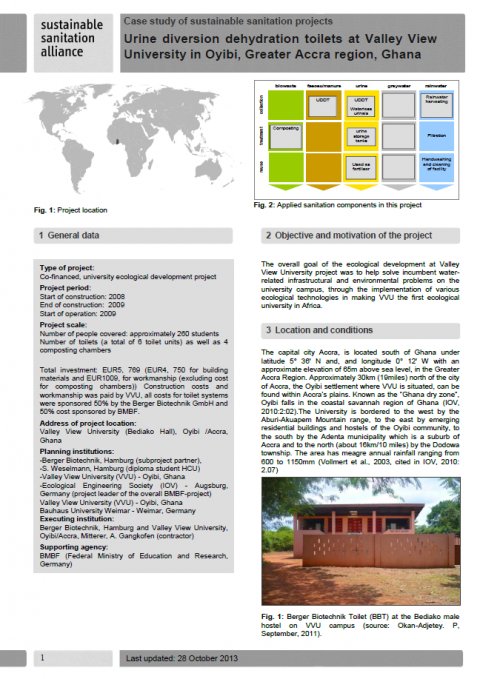Urine diversion dehydration toilets at Valley View University in Oyibi, Greater Accra region, Ghana - Case study of sustainable sanitation projects
Okan-Adjetey, P. (2013)

Published in: 2013
Publisher:
Sustainable Sanitation Alliance (SuSanA)
Author:
Okan-Adjetey, P.
Uploaded by:
SuSanA secretariat
Partner profile:
common upload
13320 Views
627 Downloads
Location of library entry
Content - Summary
The overall goal of the project was to help solve incumbent water-related infrastructural and environmental problems on the Valley View university campus, through the implementation of various ecological technologies in making VVU the first ecological university in Africa.
Advances for solving the water-problem in the university stem as far back as 1992, as the SDA church (proprietors of the University) welfare office had threatened to shut down the university due to lack of water (Okan-Adjetey, 2012: 4.26, 28). The University was not connected to Ghana’s public water supply system and had to supply water by a water tanker. To lower the associated cost, measures including saving and recycling were evaluated.
One of such measures took place in the year 2000, following the preparation of a master plan; in a quest to upgrade infrastructure and at the same time solve some of the universities water-related problems. These efforts amongst others evolved into the Research and Development (R&D) Project at VVU (Okan-Adjetey, 2012: 4.26, 28).
The R&D project, dubbed “Ecological development at Valley View University in Accra, Ghana”, was initiated by the Ecological Engineering Society (IOV) and Bauhaus University Weimar and was expanded by the integration of UHOH (University of Hohenheim), Berger Biotechnik GmbH, Palutec GmbH and CIM (Centre for international Migration and Development)
This project/aspect understudy (UDDT) constitutes a part of the holistic ecological technologies employed to help curb the infrastructural needs of the university. Except the BBT, the installations outside buildings were financed 50% Palutec GmbH and 50% BMBF. All inside installations were financed 50% Berger Biotechnik GmbH and 50% BMBF. An early proposal to commence with UDDTs was rejected as authorities of the university at the time wanted to have so called “future toilets” (Okan-Adjetey, 2012: 5.56).
The initiative to develop a specially adapted UDDT, the so called Berger Biotechnik Toilet began in 2008, as a revised alternative, as frequent lack of water and electricity made water closets – at least sporadically – unviable.
Last updated: 28 Oct. 2013
Bibliographic information
Okan-Adjetey, P. (2013). Urine diversion dehydration toilets at Valley View University in Oyibi, Greater Accra region, Ghana - Case study of sustainable sanitation projects. Sustainable Sanitation Alliance (SuSanA)
Filter tags
Case studies in SuSanA template English Schools Sub-Saharan Africa Urine diversion dehydration toilets (UDDTs)















